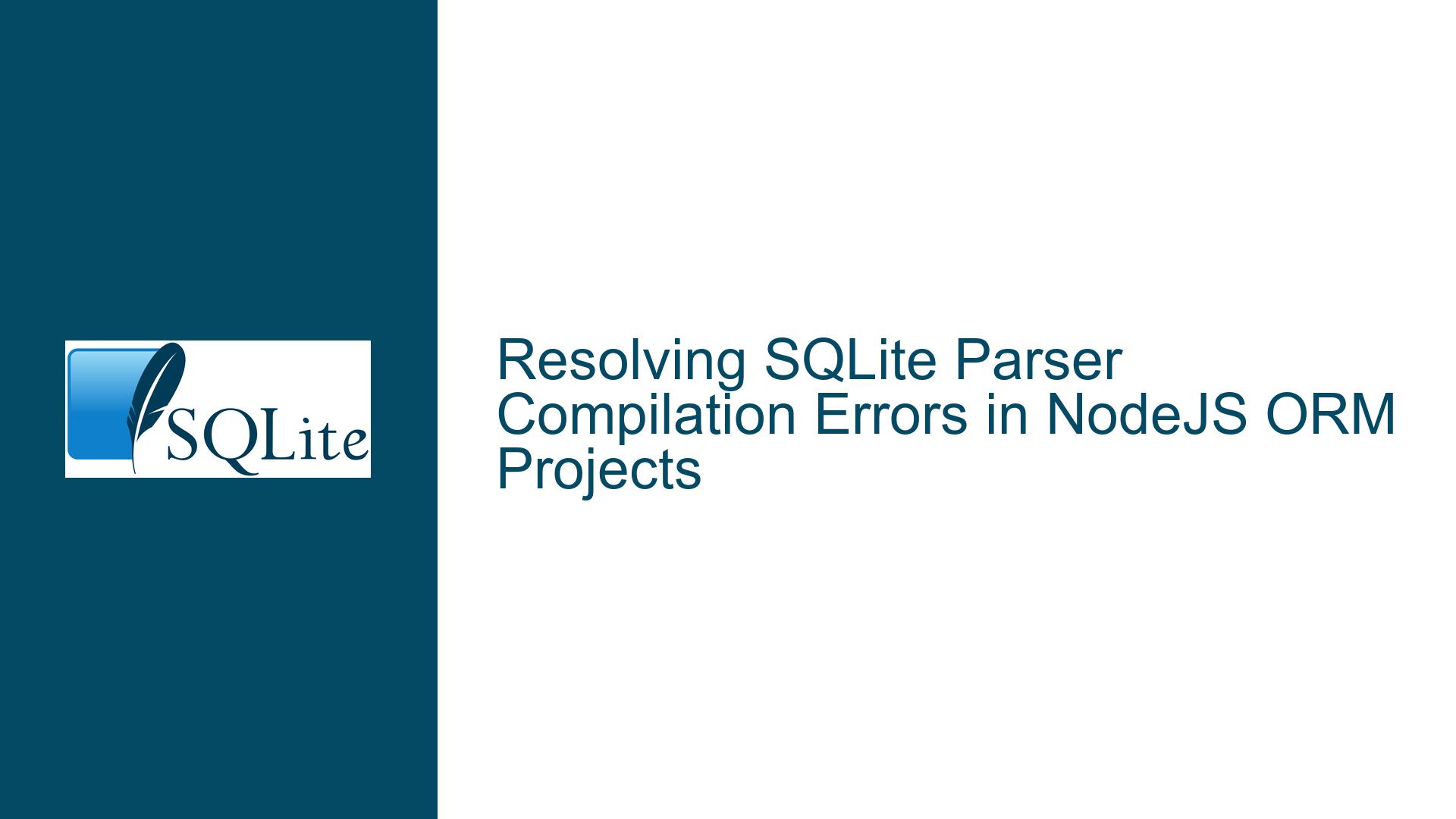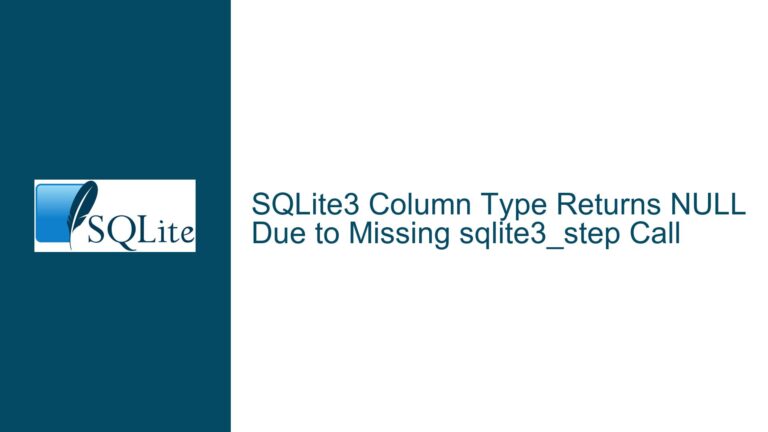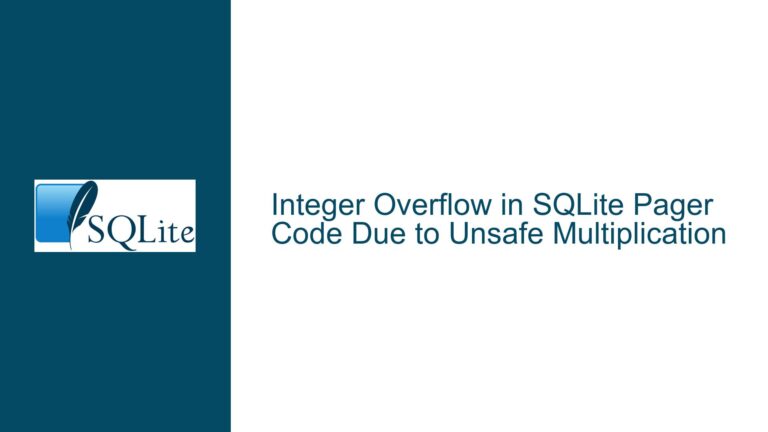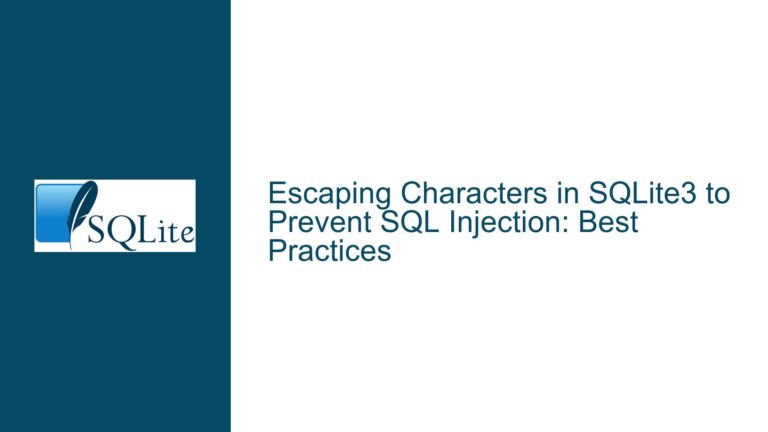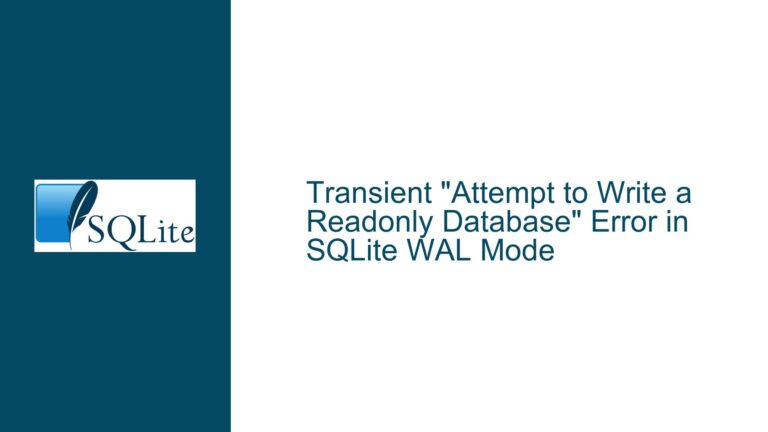Resolving SQLite Parser Compilation Errors in NodeJS ORM Projects
Compilation Failures When Extracting SQLite’s Parser for Custom AST Generation
Issue Overview: Undefined Symbol Errors During SQLite Parser Integration
The core challenge revolves around compiling SQLite’s parser, generated via the Lemon tool, into a NodeJS/JavaScript environment for the purpose of generating an abstract syntax tree (AST) to power a custom ORM. The parser’s source code (parse.c), derived from SQLite’s parse.y grammar file, includes references to internal SQLite functions declared in sqliteInt.h. These functions are part of SQLite’s private implementation details, such as routines for virtual database engine (VDBE) code generation, symbol table management, and internal error handling. When attempting to compile parse.c independently, the linker reports "undefined symbols" because these dependencies are not included in the build. The parser is intrinsically tied to SQLite’s monolithic architecture, making standalone extraction non-trivial. The problem is exacerbated by the fact that Lemon-generated parsers rely on semantic actions embedded in the grammar rules, many of which assume the presence of SQLite’s runtime environment. This creates a circular dependency: the parser requires SQLite internals to build, but the goal is to use the parser outside the SQLite codebase.
Possible Causes: Missing SQLite Internals and Tight Coupling
Undefined Symbols from
sqliteInt.h
Theparse.cfile generated by Lemon includes calls to functions likesqlite3ErrorMsg,sqlite3Dequote, orsqlite3VdbeAddOp4. These functions are defined within SQLite’s source tree (e.g., inbuild.c,vdbe.c, orutil.c) but are not exposed in public headers. ThesqliteInt.hheader acts as an internal bridge between components, and its absence in a standalone build means these symbols remain unresolved.Grammar Actions Tied to SQLite’s Execution Model
The semantic actions inparse.yare designed to construct parse trees that directly feed into SQLite’s query planner and VDBE. For example, rules forCREATE TABLEmight invokesqlite3StartTableto initialize a table structure in memory, which is irrelevant for an ORM-focused AST. These actions assume the presence of SQLite’s runtime context, including its memory allocator, error stack, and virtual machine.Incomplete Build Context
The parser is one component of SQLite’s tightly integrated codebase. Compiling it separately ignores the dependency graph that links the parser to other modules. Even ifsqliteInt.hwere available, the lack of associated.cfiles (e.g.,tokenize.c,select.c) means critical dependencies remain unmet.Lemon Toolchain Misconfiguration
Lemon generates parser code that depends on auxiliary functions likeParseFallback,ParseTrace, or tokenizer callbacks. If the build process does not include Lemon’s runtime support files or a custom tokenizer, these symbols will also be missing.
Troubleshooting Steps: Decoupling the Parser and Alternative Approaches
Step 1: Isolate the Grammar from SQLite-Specific Actions
The first task is to sanitize the parse.y grammar file by removing or replacing semantic actions that depend on SQLite internals. For example, consider the following rule from SQLite’s parse.y:
cmd ::= CREATE TABLE ifnotexists(E) nm(X) dbnm(Y) AS select(S). {
sqlite3EndTable(pParse,&X,&Y,&S);
}
The action sqlite3EndTable is specific to SQLite’s table initialization logic. Replace this with custom actions that build AST nodes instead. A minimal example would be:
cmd ::= CREATE TABLE ifnotexists(E) nm(X) dbnm(Y) AS select(S). {
// Custom action: Construct AST node for CREATE TABLE AS SELECT
ast_create_table_as_select(X, Y, S);
}
This requires defining ast_create_table_as_select in a separate C module linked into the project. Tools like node-gyp or emscripten can help bridge this C code to NodeJS.
Step 2: Leverage SQLite’s Amalgamation Build
The SQLite amalgamation (sqlite3.c, sqlite3.h) consolidates all internal modules into a single file. By including this in your build, you resolve missing symbols at the cost of increased binary size. However, many internal functions are now available:
# Download the amalgamation
wget https://www.sqlite.org/2023/sqlite-amalgamation-3420000.zip
unzip sqlite-amalgamation-3420000.zip
# Compile parser with amalgamation
gcc -I. -c parse.c -o parse.o
gcc -I. -c sqlite3.c -o sqlite3.o
gcc -o libsqlparser.so parse.o sqlite3.o -shared
This approach binds your parser to SQLite’s implementation, which may conflict with an ORM’s requirements. Use #define SQLITE_PRIVATE to expose internal symbols if necessary.
Step 3: Incremental Grammar Development
Start with a subset of SQLite’s grammar focused on expressions or SELECT statements. Use Lemon’s error recovery and %fallback directives to handle partial inputs. For example, a minimal expr.y grammar:
%include {
#include "ast.h"
// Custom AST node constructors
Expr* ast_literal(const char* value);
}
%token_type { const char* }
%extra_argument { Expr** result }
expr ::= literal(A). { *result = ast_literal(A); }
Compile this with:
lemon expr.y
gcc -c expr.c -o expr.o
Link this with a NodeJS native module that exposes expr_parse() via N-API.
Step 4: Alternative Parsers and Language Bindings
If maintaining a C-to-JS pipeline is impractical, consider these alternatives:
- Rust’s
sqlite3-parserCrate: Compile it to WebAssembly (WASM) usingwasm-pack, then import into NodeJS. This bypasses native compilation entirely. - CGSQL: Use its LL(1) grammar and existing toolchain to generate JavaScript-compatible ASTs.
- ANTLR or PEG.js: Reimplement SQLite’s grammar using a parser generator that targets JavaScript directly.
Step 5: Custom Tokenizer and Symbol Table
SQLite’s parser expects a tokenizer that conforms to its sqlite3Parser interface. Implement a standalone tokenizer in C that emits tokens compatible with your AST:
typedef struct yy_extra {
sqlite3ParserCTX* ctx;
TokenStream* tokens;
} yy_extra;
void yylex(YYSTYPE* yylval, yy_extra* extra) {
Token* t = next_token(extra->tokens);
yylval->token = t->value;
return t->type;
}
Bind this tokenizer to NodeJS using node-ffi-napi or emscripten’s EMSCRIPTEN_KEEPALIVE exports.
Step 6: Build System Integration
Use node-gyp to automate compilation of C modules. A sample binding.gyp:
{
"targets": [{
"target_name": "sqlparser",
"sources": ["parse.c", "ast.c", "tokenizer.c"],
"include_dirs": ["<!(echo $SQLITE_AMALGAMATION_PATH)"],
"libraries": ["-lsqlite3"]
}]
}
Run node-gyp configure build to generate platform-specific binaries.
Step 7: Testing and Validation
Validate the extracted parser against SQLite’s own test suite. Use the sqlite3 command-line tool to generate reference ASTs:
echo "SELECT 1 + 2;" | sqlite3 :memory: '.testctrl parser_trace 1'
Compare this output with your AST to ensure syntactic equivalence.
Final Considerations
Extracting SQLite’s parser requires balancing between leveraging its battle-tested grammar and decoupling from its runtime. While integrating the amalgamation offers a quick path to resolving undefined symbols, it introduces bloat. A hybrid approach—customizing the Lemon grammar, using incremental builds, and binding critical C modules to NodeJS—provides a sustainable foundation for AST generation in ORM projects. For teams lacking C expertise, Rust/WASM or JavaScript-native parsers like CGSQL present viable alternatives.
